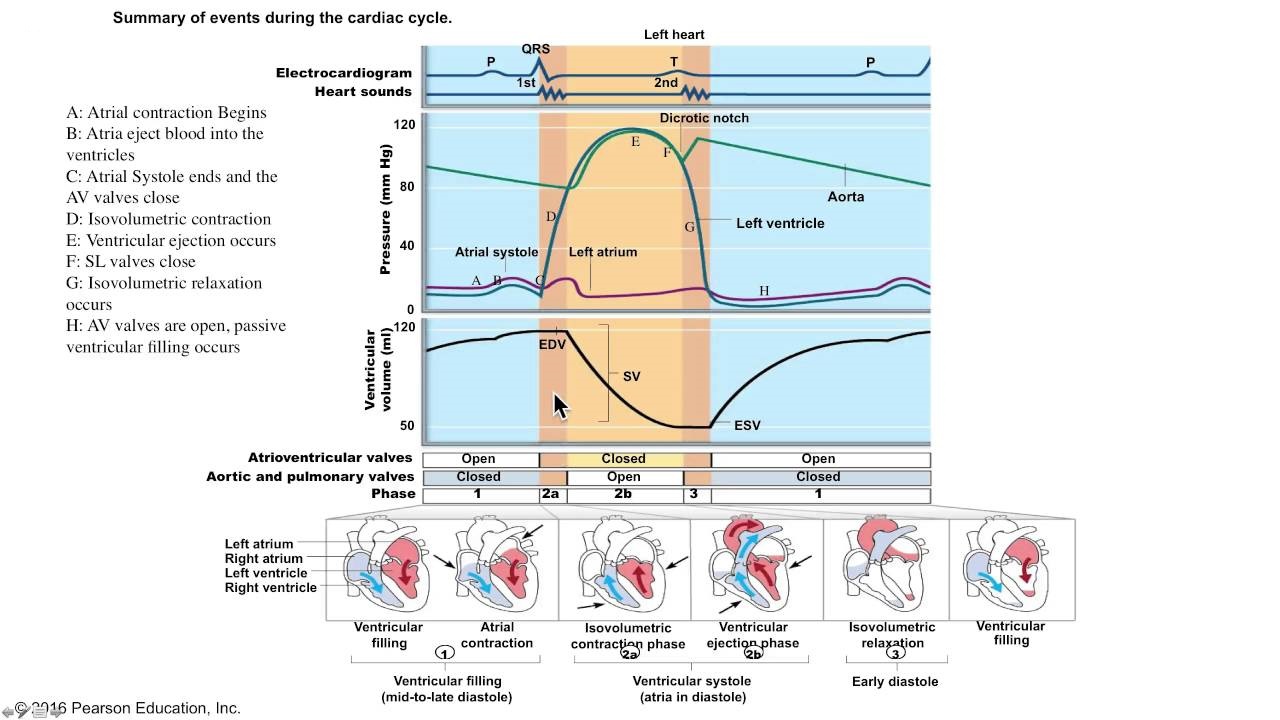Cardiac Cycle and Question Answer for NEET, GPAT, Nursing, Pharmacist and Lab Technician Exam
Cardiac cycle
The cardiac cycle is defined as a cycle which includes all the events associated with one heart beat. cardiac cycle consist of contraction(systole) and relaxation(diastole) of both atria and ventricles.
In each cardiac cycle, the atria and ventricles contract and relax. This alternating contraction and relaxation forces the blood to move from high pressure areas to the areas of low pressure. When a chamber of heart contracts, it develops pressure within the chamber and the blood moves to low pressure areas. When heart rate is 75 beats/min, the cardiac cycle is of 0.8 sec. The events associated with cardiac cycle are-
Atrial Systole
The atrial systole is for 0.1 sec; during this period the atria contract and ventricles relax.
- depolarization of SA node causes the atrial depolarization; which is marked by P wave in the ECG.
- Atrial depolarization causes atrial systole. As the atria contract, they exert pressure within; this causes the blood to move through the AV valves.
- Due to atrial systole, the total volume of 25ml of blood reaches to the ventricles which already contains 105ml of blood within it.
- At the end of atrial systole, which is also the end of ventricular diastole; the ventricles contain 130ml of blood. This volume of blood is known as end diastolic volume (EDV).
Ventricular Systole
The ventricular systole is for 0.3 sec; during this period, the ventricles contract and the atria are relaxed.
5. The QRS complex of ECG marks the ventricular depolarization on the ECG. The ventricular depolarization causes ventricular systole.
6. As the ventricles contract, pressure rises within the ventricles and pushes the blood up against the AV valves forcing them to shut. for about 0.005 sec, both the AV valves and semilunar valves are closed; this period is known as isovolumetric contraction.
7. When the left ventricle crosses the pressure of 80mmHg and the right ventricle crosses the pressure of 20mmHg; both the aorta and pulmonary trunk opens. This period is known as ventricular ejection and is for 0.25 sec.
8. The ventricles eject about 70ml of blood after contractions within it. The volume that remains after ejection is known as end systolic volume(ESV); which is about 60ml.
9. The stroke volume(SV) equals to SV=EDV-ESV, that is 130-60ml=70ml.
Relaxation period
This period is for 0.4 sec. During this period, both the atria and ventricles relax. Ventricular repolarization causes ventricular relaxation. This is marked by T wave on the ECG.
The relaxation period is for longer time than the contraction period because if the cardiac muscles relaxes for longer duration, more powerful and forceful is the next contraction. this results in more stroke volume; hence more cardiac output.
Multiple choice questions(MCQs)
1. What is cardiac cycle?
A. blood ejected from the ventricles to the body
B. blood ejected from atria to the ventricles
C. events associated with each heart beat
D. event associated with each heart rate
2. For how long is the cardiac cycle, if the heart rate is 75 beats/min?
A. 0.7 sec B. 0.8 sec
C 0.5 sec D. 0.4 sec
3. Which event is associated with cardiac cycle?
A. atrial systole B. ventricular systole
C. relaxation period D. all of the above
4. The atrial depolarization is marked by which wave on the ECG?
A. P wave B. QRS complex
C. T wave D. U wave
5. Match the following-
A. cardiac cycle 1. 0.3 SEC
B. atrial contraction 2. 0.8 SEC
C. ventricular contraction 3. 0.1 SEC
D. ventricular relaxation 4. 0.4 SEC
6. After the contraction of atria, how much volume of blood flows from atria to the ventricles through AV valves?
A. 30ml B. 25ml
C. 15ml D. 22ml
7. What is the time period for ventricular systole?
A. 0.3 sec B. 0.1 sec
3. 0.4 sec D. 0.5 sec
8. Which of the following statement is true?
A. Blood flows from lower pressure areas to higher pressure areas
B. EDV is about 140ml for heart rate of 75beats/min
C. left ventricle crosses pressure of 80mmHg to open the aorta
D. ventricular ejection is for 0.005 sec
9. Why the relaxation period is longer than contraction period?
A. more time for the cardiac muscles to relax before contraction
B. no specific reason to it
C. so that more forceful is next contraction
D. both A and C
10. What is the accurate formula of stroke volume?
A. EDV+ESV B. EDV*ESV
C. ESV-EDV D. none of the above
ANSWERS:-
1. events associated with each heart beat
2. 0.8 sec
3. all of the above
4. P wave
5. A – 2 B – 3 C – 1 D – 4
6. 25ml
7. 0.3 se
8. left ventricle crosses pressure of 80mmHg to open the aorta
9. Both A and C
10. none of the above
Participate in Online FREE GPAT TEST: CLICK HERE
Participate in Online FREE Pharmacist TEST: CLICK HERE
Participate in Online FREE Drug Inspector TEST: CLICK HERE
Reference:-Gerard J. Tortora -Principles of anatomy and physiology; edition twelfth ; page no.-: 7738-739.
